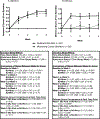One Month of Cannabis Abstinence in Adolescents and Young Adults Is Associated With Improved Memory
- PMID: 30408351
- PMCID: PMC6587572
- DOI: 10.4088/JCP.17m11977
One Month of Cannabis Abstinence in Adolescents and Young Adults Is Associated With Improved Memory
Abstract
Objective: Associations between adolescent cannabis use and poor neurocognitive functioning have been reported from cross-sectional studies that cannot determine causality. Prospective designs can assess whether extended cannabis abstinence has a beneficial effect on cognition.
Methods: Eighty-eight adolescents and young adults (aged 16-25 years) who used cannabis regularly were recruited from the community and a local high school between July 2015 and December 2016. Participants were randomly assigned to 4 weeks of cannabis abstinence, verified by decreasing 11-nor-9-carboxy-∆⁹-tetrahydrocannabinol urine concentration (MJ-Abst; n = 62), or a monitoring control condition with no abstinence requirement (MJ-Mon; n = 26). Attention and memory were assessed at baseline and weekly for 4 weeks with the Cambridge Neuropsychological Test Automated Battery.
Results: Among MJ-Abst participants, 55 (88.7%) met a priori criteria for biochemically confirmed 30-day continuous abstinence. There was an effect of abstinence on verbal memory (P = .002) that was consistent across 4 weeks of abstinence, with no time-by-abstinence interaction, and was driven by improved verbal learning in the first week of abstinence. MJ-Abst participants had better memory overall and at weeks 1, 2, 3 than MJ-Mon participants, and only MJ-Abst participants improved in memory from baseline to week 1. There was no effect of abstinence on attention: both groups improved similarly, consistent with a practice effect.
Conclusions: This study suggests that cannabis abstinence is associated with improvements in verbal learning that appear to occur largely in the first week following last use. Future studies are needed to determine whether the improvement in cognition with abstinence is associated with improvement in academic and other functional outcomes.
Trial registration: ClinicalTrials.gov identifier: NCT03276221.
© Copyright 2018 Physicians Postgraduate Press, Inc.
Figures


References
-
- Johnston LD, O’Malley PM, Miech RA, Bachman JG, Schulenberg JE. Monitoring the Future national survey results on drug use, 1975–2016: Overview, key findings on adolescent drug use. Ann Arbor: Institute for Social Research; 2017.
-
- Giedd JN, Blumenthal J, Jeffries NO, Castellanos FX, Liu H, Zijdenbos A, et al.: Brain development during childhood and adolescence: a longitudinal MRI study. Nat Neurosci 1999; 2:861–8633. - PubMed
-
- Sowell ER, Thompson PM, Holmes CJ, Batth R, Jernigan TL, Toga AW: Localizing age-related changes in brain structure between childhood and adolescence using statistical parametric mapping. NeuroImage 1999;9(6 Pt 1):587–597. - PubMed
-
- Benes FM, Turtle M, Khan Y, Farol P: Myelination of a key relay zone in the hippocampal formation occurs in the human brain during childhood, adolescence, and adulthood. JAMA Psychiatry 1994;51:477–484. - PubMed
Publication types
MeSH terms
Substances
Associated data
Grants and funding
LinkOut - more resources
Full Text Sources
Medical
Miscellaneous
